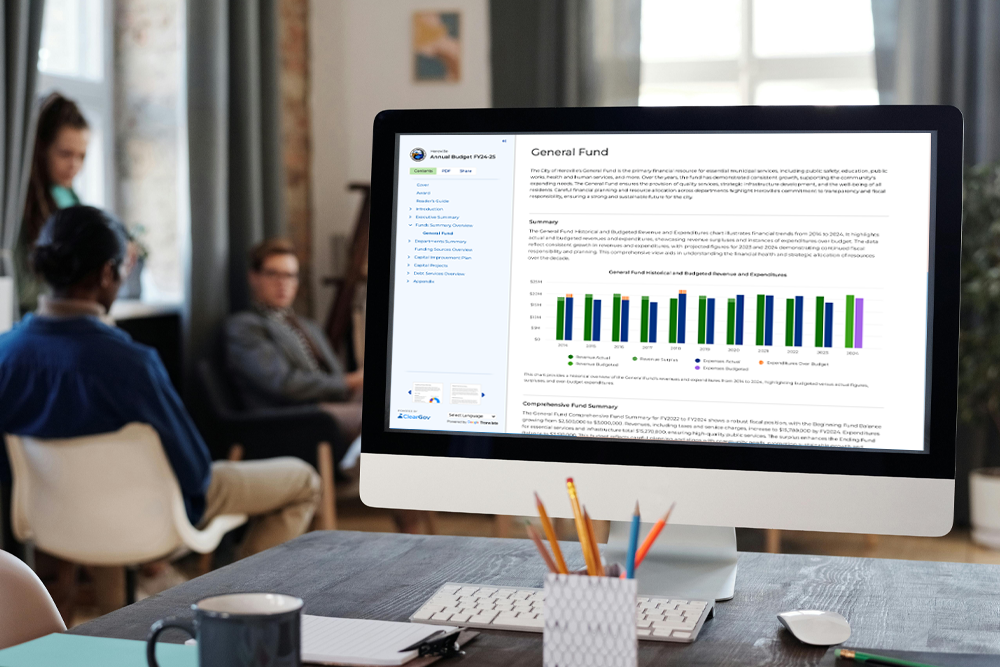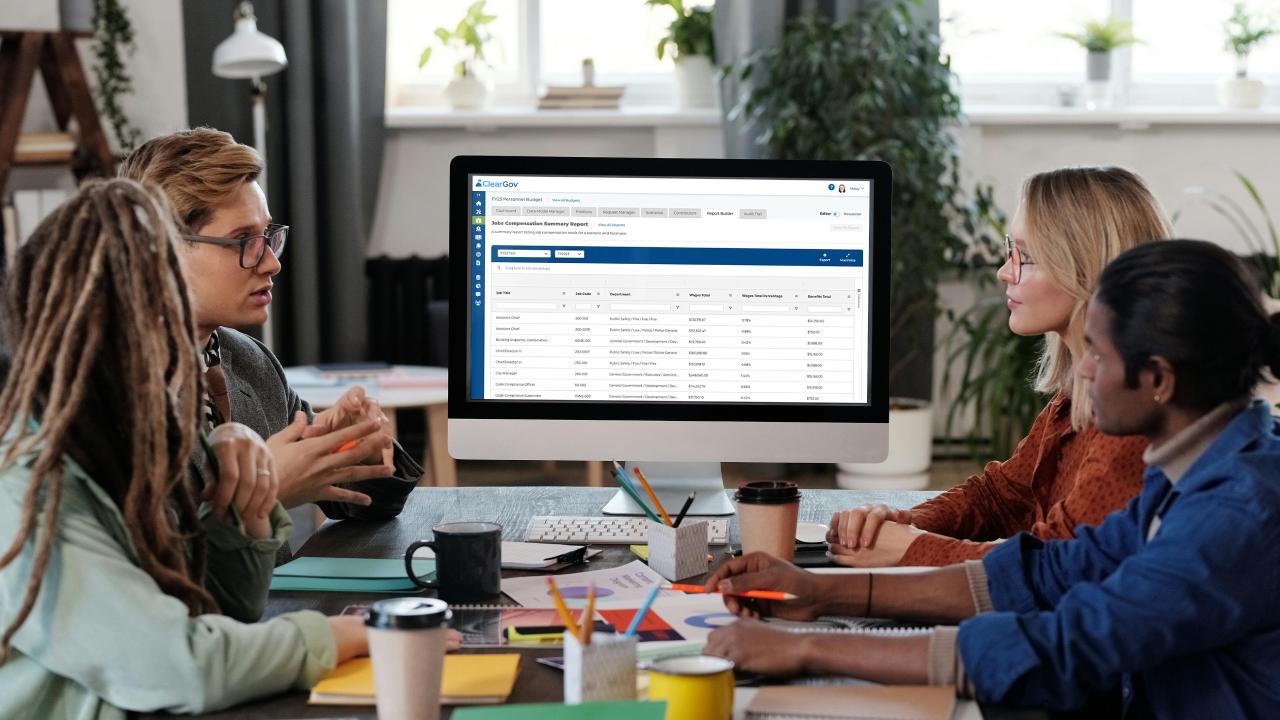Using ARPA Funds To Modernize Your Government Budgeting Process *This article was updated August 8, 2024 from the original version published February 22, 2022. New information has been added to highlight the deadline to obligate ARPA funds, and how finance staff can advocate for investment in technology, like ClearGov. How To Advocate For Investments In Technology Using ARPA FundsClearGov government budgeting software meets the criteria for using ARPA funds under general government services. In a nutshell, ClearGov:
The challenge many local governments face is hesitancy or red tape from their buying groups. While finance staff may see the clear value in using ARPA funds for technology investments—both for immediate recovery and long-term growth—the reality is that the buying process can be slow. If you need help making the case for ClearGov to your decision-makers, emphasize these key points:
For more information on the ARPA deadline to support your case, check out our recent article The Potential of the Remaining 30% ARPA Fund Obligations for Local Governments. Interpreting The Final RuleThe ability to use lost revenue funds for general government services opens up many opportunities for governments to infuse their communities with valuable services and programs. Additionally, the Treasury states that, “Funds spent under government services are subject to streamlined reporting and compliance requirements,” giving governments greater autonomy over allocating funds where they’re most needed. For some, the lost revenue funds will be found money, as governments don’t have to show a loss to be eligible for the funds. For others, it will help refill their coffers; they will be making up for a true loss. State and local governments are encouraged to read the Final Rule to help them determine which revenue loss option to take and how to best use funds. Have There Been Changes To The SLFRF Final Rule? There have been amendments to the SLFRF program since the Final Rule took effect on April 1, 2022. Specifically, the Consolidated Appropriations Act of 2023, enacted on December 29, 2022 included changes to the SLFRF program. The act provided additional flexibility for using SLFRF funds for natural disaster relief, transportation infrastructure, and community development. Additionally, an Interim Final Rule on September 20, 2023 clarified the obligation deadline for SLFRF funds and provided guidance for subrecipients.
Replacing Lost Revenue: What The Final Rule SaysAccording to the US Department of Treasury, “The final rule offers a standard allowance for revenue loss of up to $10 million, allowing recipients to select between a standard amount of revenue loss or complete a full revenue loss calculation.” State and local governments do not have to use the Treasury revenue loss formula to prove loss — every government is eligible for the $10MM. Governments can: 1. Take up to $10 million standard allowance for revenue loss, OR 2. Calculate revenue loss with the Treasury formula, with a new 5.2% default growth rate (increased from 4.1%) It is advisable to do the full revenue loss calculation to see which option is more favorable. What Lost Revenue Can Be Used For: General Government ServicesThe final rule states that the funding can be used on “general government services,” which includes general government administration, staff, and administrative facilities. The Treasury’s explanation of using funds on general government services is as follows: “Recipients can use SLFRF funds on government services up to the revenue loss amount, whether that be the standard allowance amount or the amount calculated using the above approach. Government services generally include any service traditionally provided by a government, unless Treasury has stated otherwise. Here are some common examples, although this list is not exhaustive: ✓ Construction of schools and hospitals ✓ Road building and maintenance, and other infrastructure ✓ Health services ✓ General government administration, staff, and administrative facilities ✓ Environmental remediation ✓ Provision of police, fire, and other public safety services (including purchase of fire trucks and police vehicles)” What Lost Revenue Can Be Used For: Effective Service DeliveryFor many state and local governments, the explanation for general government services is enough to justify spending ARPA funds on administrative software to help them operate more efficiently and better serve their communities. But additional clarification can be found under the rules for “Effective Service Delivery.” The Treasury’s explanation for using funds for effective service delivery is as follows: “SLFRF funding may be used to improve the efficacy of public health and economic programs through tools like program evaluation, data, and outreach, as well as to address administrative needs caused or exacerbated by the pandemic. Eligible uses include: Supporting program evaluation, data, and outreach through: ✓ Program evaluation and evidence resources ✓ Data analysis resources to gather, assess, share, and use data ✓ Technology infrastructure to improve access to and the user experience of government IT systems, as well as technology improvements to increase public access and delivery of government programs and services ✓ Community outreach and engagement activities ✓ Capacity building resources to support using data and evidence, including hiring staff, consultants, or technical assistance support Addressing administrative needs, including: ✓ Administrative costs for programs responding to the public health emergency and its economic impacts, including non-SLFRF and non-federally funded programs ✓ Address administrative needs caused or exacerbated by the pandemic, including addressing backlogs caused by shutdowns, increased repair or maintenance needs, and technology infrastructure to adapt government operations to the pandemic (e.g., video-conferencing software, data and case management systems)” Interpreting The Final RuleThe ability to use lost revenue funds for general government services opens up many opportunities for governments to infuse their communities with valuable services and programs. Additionally, the Treasury states that, “Funds spent under government services are subject to streamlined reporting and compliance requirements,” giving governments greater autonomy over allocating funds where they’re most needed. For some, the lost revenue funds will be found money, as governments don’t have to show a loss to be eligible for the funds. For others, it will help refill their coffers; they will be making up for a true loss. State and local governments are encouraged to read the Final Rule to help them determine which revenue loss option to take and how to best use funds. ClearGov Government Budgeting Software Modernizes Your Budgeting ProcessClearGov government budgeting software meets the criteria for using ARPA funds under the general government services or the effective service delivery categories, as it:
If you have found money from your ARPA lost revenue allowance, see how you can modernize your budget cycle processes with ClearGov! Schedule a demo today and start budgeting better. |












